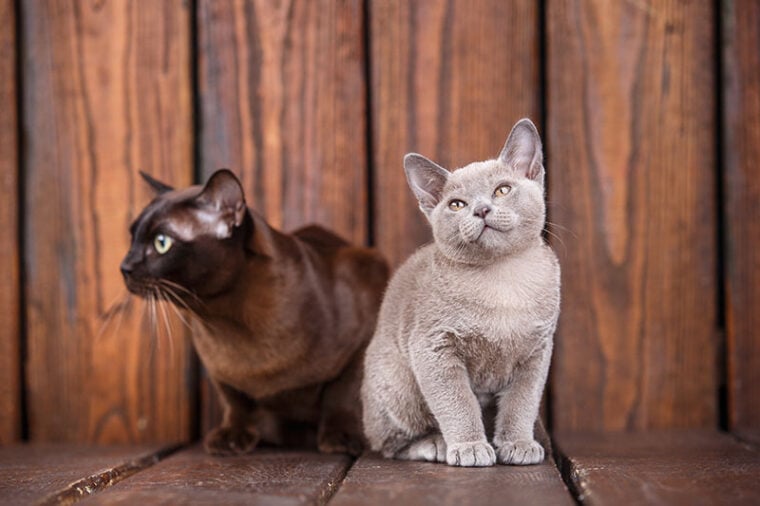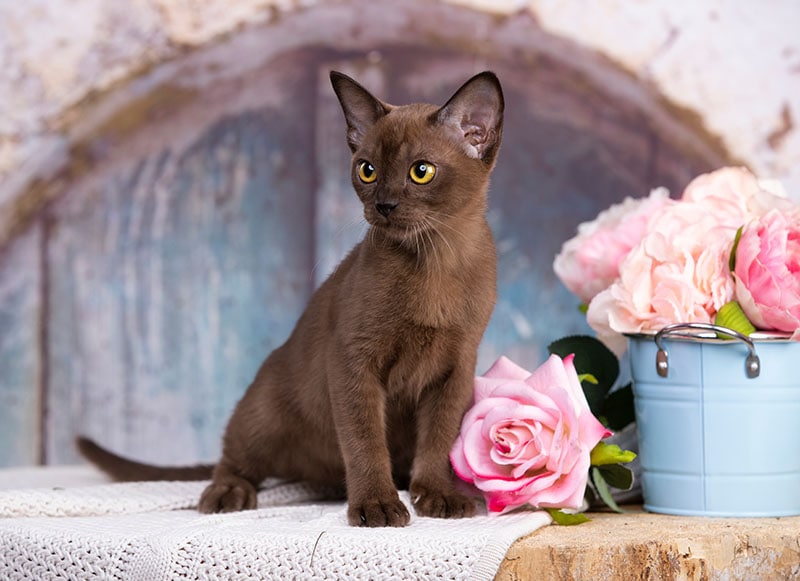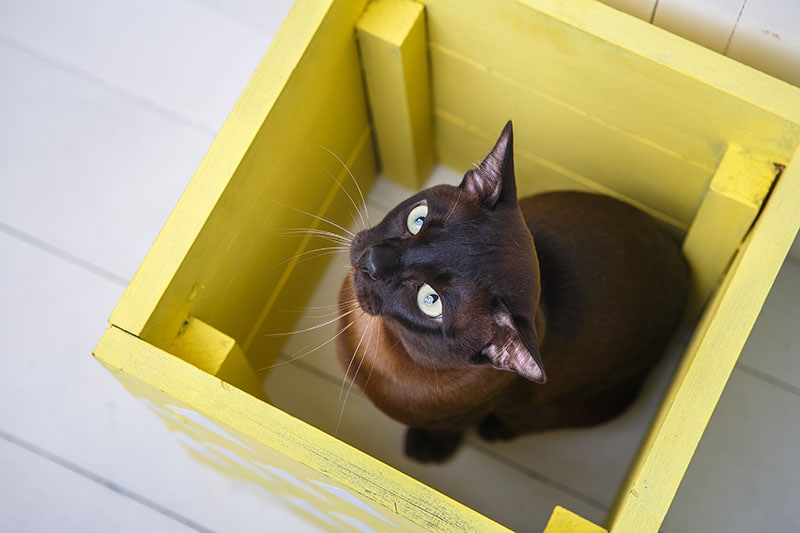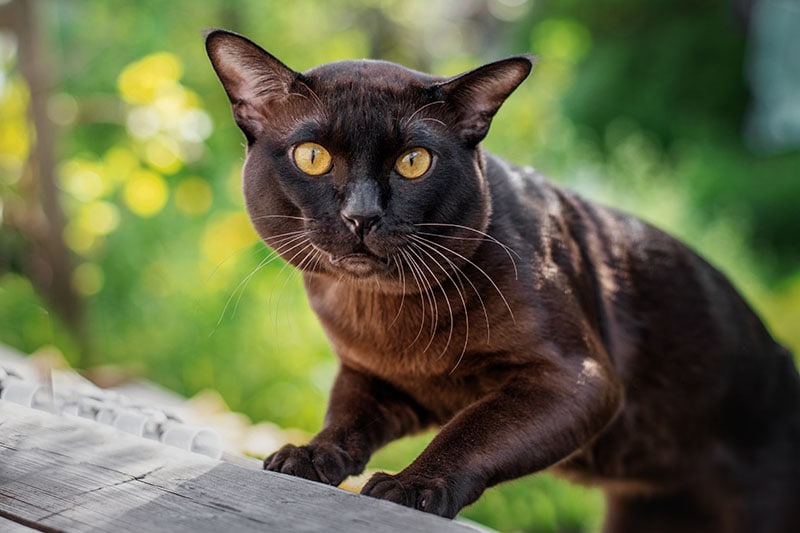
Click Below to Skip Ahead
Are you on the hunt for the perfect kitty companion? Do you enjoy snuggles and companionship? If so, the European Burmese could be the perfect cat for your home. This sociable breed is not only gorgeous, but they are also playful and open to being part of the family. Check out some of these characteristics below to learn more about the European Burmese.
Breed Overview
Height:
10–12 inches
Weight:
7–14 pounds
Lifespan:
10–15 years
Colors:
Blue, brown, chocolate, red, chocolate tortoiseshell, brown tortoiseshell, lilac, cream, chocolate cream, blue cream, and lilac cream
Suitable for:
Singles or families looking for a companion, owners who aren’t away from home for extended periods
Temperament:
Loyal, intelligent, loving, friendly, playful, does well with other pets
The European Burmese has a slim and elegant contoured body. The eyes of this cat are slightly curved, slanting slightly toward the nose. This elegant look makes a lot of sense considering legends tell Burmese cats were the original temple cats before the Siamese garnered the honor. These cats even had novice monks assigned to be at their beck and call.
This breed is excellent in both single-owner and family settings. They are playful, loving, and highly intelligent. They even get along great with other pets. However, if you travel a lot or plan on leaving this cat breed alone for extended periods, the European Burmese may not be the right cat for you unless you opt to get more than one. These kitties thrive on companionship. Being left alone isn’t the best thing for a European Burmese so make sure you keep this in mind.
European Burmese Characteristics
European Burmese Kittens

European Burmese kittens have been described as dog-like in their actions. They are inquisitive kitties that love to investigate. This means you will need to keep a close eye on them as they explore the house. Small kittens can access areas larger cats cannot. It is also very important to take your European Burmese kitten to the vet soon as possible. This will ensure they are healthy, dewormed, and start life on the right foot with proper vaccinations and screenings.
While it is possible to find a European Burmese at a shelter or sanctuary, most likely you will find yourself reaching out to a breeder to bring your new kitten into the home. Not only should you research the breeder to ensure they are ethical and take great care of their kittens, but you’ll also need to get everything your kitty needs to be happy in its new environment. You’ll need kitten food, a litter box, litter, food and water bowls, a cat bed, toys, a brush, and a collar if you wish. It is best to be prepared and have all of these items before you bring your kitty home for the first time.
Temperament & Intelligence of the European Burmese
The European Burmese is an extremely well-mannered cat. Perhaps it has something to do with their royal history. Don’t think these kitties are stuck up, however. These cats love to be the center of attention. Whether it is with their owner, the entire family, or guests that stop by, these cats are quite social, love to cuddle, and will play with anyone kind to them.
The intelligence of the European Burmese is quite well-known as well. These cats love puzzle toys and games that keep their minds sharp. You’ll also find that if you start young, you can easily teach your European Burmese a few feats that will take everyone’s breath away.

Are These Dogs Good for Families? 👪
Yes, European Burmese cats are excellent for families. While many cat breeds prefer to steer clear of children, this breed sees them as great play companions. Parents should carefully monitor the situation when kids and a European Burmese are playing. These cats are considered a bit small in size. A child that hasn’t been taught how to interact with a pet properly could easily hurt the kitty.
Does This Breed Get Along with Other Pets?
Yes, due to their amazing social grace, European Burmese cats do great with other cats and even dogs. The key when having multiple pets in the home is to work on socialization early. Introduce your European Burmese to other pets in the home slowly and give them all time to work on the relationship. If done properly, you may witness lots of active play between all of your pets in no time.
Keep in mind, a cat will be a cat. While this breed loves being sociable, allowing them to spend time with smaller animals in your home could be dangerous. Cats are natural hunters. Hamsters, mice, other rodents, and reptiles in the home could become a target and should be watched carefully when in the presence of any cat.
Things to Know When Owning a European Burmese:
Let’s take a quick look at a few things you should know about your European Burmese before you bring it into your home. This will make life easier for you, your family, and especially your new kitty.
Food & Diet Requirements 
Choosing the right food for any pet in your home is important. When it comes to cats, however, you must remember that they are obligate carnivores. This means they get most of the nutrients they need from meat. When buying food you will need to ensure it is a high-quality cat food with lots of protein. You’ll also need to provide your European Burmese with access to fresh, clean water daily.

Exercise 🐈
Cats enjoy sleeping a lot so when they are awake, you must see to their exercise needs. For European Burmese cats, this consists of playing. Make sure your kitty has access to lots of toys. They especially enjoy interactive and puzzle games.
Training🧶
Training for cats is quite a bit different than it is for dogs. Cats can be trained in simple things like fetch, to come when they are called, and other games with their owners. European Burmese cats are highly intelligent so make sure you attempt to teach them things and interact with them a lot. Training will also consist of teaching your kitty to use the litter box, stay off counters, and avoid certain things in the house.
Grooming ✂️
If you’ve had other cats in your home, you are already aware that they do most of their own grooming. This doesn’t mean they won’t need a bit of help from you. This is especially true when it comes to their teeth. European Burmese are known for dental issues. To avoid this, make sure you clean your kitty’s teeth regularly. If possible, do it each day. If not, at least once a week. You’ll also want to clean your kitty’s ears routinely with water and apple cider vinegar. Simply apply these to a damp washcloth and clean gently.

Health and Conditions 🏥
Overall, the European Burmese is a healthy cat breed. However, they are prone to certain issues. They are vulnerable to eye issues and heart problems. We’ve already mentioned they suffer from dental issues like gingivitis but they also have a sensitivity to anesthesia. Let’s take a look at other issues a European Burmese may deal with throughout their lives.
Male vs Female
When it comes to the differences between male and female European Burmese cats you won’t find many as far as physical appearance. What you will notice is that males of this breed are far more laid back. A male European Burmese will play with you and the family, but they are also very content to curl up on your lap and just chill. Females, however, completely embrace the diva persona that so many cats are given. When a female of this breed walks into the room, she wants attention. She will reach out socially and expects that to be reciprocated. While they may be divas, that doesn’t mean they aren’t just as loving as males.
3 Little-Known Facts About The European Burmese
1. The European Burmese Is a Separate Breed from a Burmese
While the origins of both of these cat breeds come from the same cat, they are viewed by cat clubs as independent breeds. In appearance, the Burmese are a stockier, more rounded cat. The European Burmese is more elegant and shapely.
2. Wong Mau, a Siamese, Is the Matriarch of the European Burmese
As we mentioned above, both the Burmese and the European Burmese come from the same cat. This matriarch is Wong Mau, a brown Siamese.
3. European Burmese Cats Aren’t Happy When Alone
This cat breed does not enjoy having the house to themselves. The European Burmese is known for suffering from separation anxiety when their owners are away for long periods. If you plan on bringing one of these cats into your life, make sure you have the time to dedicate to being their companion.

Final Thoughts
As you can see, the European Burmese is an all-around amazing cat breed. Whether you are looking for a kitty pal to fend off the loneliness of being single, are elderly and want a friend, or have a family looking for a perfect playmate and addition, this breed will work perfectly. Keep in mind, however, that these cats, although playful and great with children, are on the smaller side and can be hurt if your kids aren’t taught how to treat them early on in the relationship.
Featured Image Credit: Frau aus UA, Shutterstock





